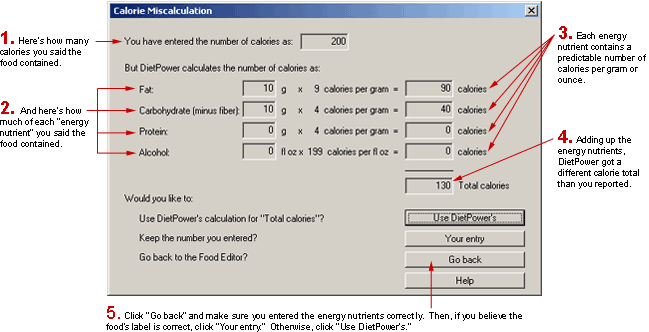
DietPower Help
At a Glance
When you add foods to the dictionary, Diet Power checks your math. The Calorie Miscalculation dialog appears when the program notices a disparity between the calories and the energy nutrients you entered.

In Detail
Occasionally, when you try to add a food to the dictionary or edit one already there, Diet Power responds by showing you the Calorie Miscalculation dialog, advising that the nutrients you've entered don't jibe with the number of calories you report. Before writing the food into the dictionary, Diet Power needs to know what you want to do about this disparity. To help you decide, here's a bit of background:
Almost all of the calories in any food come from the four "energy nutrients":
Fat usually provides nine calories per gram.
Carbohydrate supplies only about four calories per gram
(which explains why fruit and pasta aren't as fattening as meat and french
fries). Exception: Dietary fiber and functional fiber, both forms of carbohydrate, contribute very few calories
because they pass through the body virtually undigested. Diet Power and
most food companies assume their contribution to be zero.
Protein
generally contributes four calories per gram—the
same as carbohydrate.
Alcohol supplies about seven calories per gram, or 199 calories per fluid ounce.
Keep in mind, however, that these calories-per-gram formulae are only approximate. Depending on its exact chemical makeup, a food's caloric value may be as much as 20 or 30 percent off the standard.
When you submit a new or revised food to the dictionary, Diet Power totes up the calories from the four energy-nutrient amounts that you entered and compares this with the number you entered in the Calories column. If the two figures differ by more than 5 percent, the program asks whether you want to keep your own calorie total or use Diet Power's. Which should you trust?
First, if the disparity is small and the food seldom eaten, don't take the problem too seriously. It won't matter much in the grand scheme of things. But if the food is one of your staples and the difference is large, try the following:
Compare the figures
on the food's label with those you typed on the screen. You might have
copied incorrectly. Or perhaps you cut the serving size in half, but forgot
to halve the calories or one of the energy nutrients. If so, click the
"Go Back" button and fix the error.
If the figures still
don't agree, it's possible—though
not likely—that
the food company made a mistake. You might be able to obtain corrected
figures by phoning the toll-free number listed on many labels.
If these steps don't answer the question, you may gain some insight by checking the nutrient profiles of similar foods already in the dictionary. (To reopen the Dictionary page without discarding your work, you must first get rid of the Calorie Miscalculation by answering it. Just reply either way; you can re-edit the food later if you guess wrong.)
When you've decided which calculation you prefer, click the "Diet Power's Calculation" or the "Your Entry" button. The Calorie Miscalculation dialog will vanish and the food will be written into the dictionary.
Got a Suggestion for This Page?
Last Modified: 6/29/07